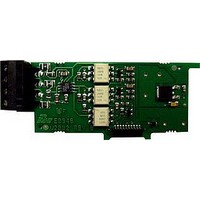PAXCDC10 Red Lion Controls, PAXCDC10 Datasheet - Page 22

PAXCDC10
Manufacturer Part Number
PAXCDC10
Description
RS485 Serial Communications Output Interface Card With Terminal Block
Manufacturer
Red Lion Controls
Specifications of PAXCDC10
Accessory Type
RS485 Serial Communications Output Interface Card With Terminal Block
Brand/series
PAX Series
Card Type
RS485 Serial Communications Output Card
Data Rate
7⁄8 Bits
Standards
cULus Listed, CSA Certified and CE Marked
Voltage, Working
50 V
Pax Label Kit
189 Different Engineering Units, Labels Inserted Inside the Unit
For Use With
Red Lion PAX Digital Input Panel Meters
Lead Free Status / RoHS Status
Lead free / RoHS Compliant
Quick Programming Mode when the setpoint is configured as
(See Module 2 for Exchange Parameter Lists explanation.)
programmed (“n”) will track the entered selection’s value. Tracking means that
when the selection’s value is changed (in the Quick Programming Mode), the
“n” setpoint value will also change (or follow) by the same amount.
exceeds the setpoint value.
value is less than or equal to the setpoint.
PAXC & I: SETPOINT ASSIGNMENT
Select the display that the setpoint is to be assigned.
Enter the desired setpoint value. Setpoint values can also be entered in the
If a selection other than NO is chosen, then the value of the setpoint being
For Rate Assignments:
For Counter Assignments:
activates the output when the assigned display value (
: When not using a setpoint, it should be set to
With Latch action, the setpoint output activates when the rate
value is equal to the setpoint value. The setpoint output remains
active until reset. If after reset, the rate value is greater than or
equal to (for
setpoint value, the output will reactivate.
With Boundary action, the setpoint output activates when the
rate value is greater than or equal to (for
or equal to (for
will deactivate (Auto reset) as determined by the hysteresis
value.
With Timed Out action, the setpoint output cycles when the rate
value is greater than or equal to (for
equal to (for
(
cycling times.
With Latch action, the setpoint output activates when the count
value equals the setpoint value. The output remains active until
reset. This action is not associated with Boundary types.
With boundary action, the setpoint output activates when the
count value is greater than or equal to (for
or equal to (for
will deactivate when the count value is less than (for
or greater than (for
With Timed Out action, the setpoint output activates when the
count value equals the setpoint value and deactivates after the
Time Out value. This action is not associated with Boundary
types.
SETPOINT BOUNDARY TYPE
SETPOINT TRACKING *
) and Setpoint On Delay (
SETPOINT ACTION
SETPOINT VALUE
activates the setpoint when the assigned display
=
=
=
=
) or less than or equal to (for
) the setpoint value. The Setpoint Time Out
to
) the setpoint value. The setpoint output
) the setpoint value. The setpoint output
=
) the setpoint value.
) values determine the
=
(no action).
) or less than or
=
=
) or less than
) or less than
in Module 3.
) equals or
=
=
) the
)
22
value crosses into the alarm “off” area. Once in the alarm “off” area, the
setpoint will function according to the configured setpoint parameters.
), the setpoint value to determine at what value to deactivate the associated
setpoint output. Hysteresis is only available for setpoints assigned to the Rate
with boundary action.
deactivation requirements (below hysteresis for high acting and above
hysteresis for low acting) before the setpoint’s output deactivates.
requirements (below setpoint for
the setpoint’s output activates. If the Rate Setpoint Action is Timed Out, this is
the amount of time the output is off during the on / off output cycling.
this is the amount of time the output is on during the on / off output cycling. If
the setpoint action is Timed Out and the setpoint is assigned to Count, then this
is the amount of time the output will activate once the count value equals the
setpoint value.
PAXC & I: COUNTER AUTO RESET *
(
different than the Counter’s Reset Action (x
*
PAXI & R: SETPOINT HYSTERESIS *
PAXI & R: SETPOINT OFF DELAY *
PAXI & R: SETPOINT ON DELAY *
Factory Setting can be used without affecting basic start-up.
Selecting
The hysteresis value is added to (for
This is the amount of time the Rate display must meet the setpoint
This is the amount of time the Rate display must meet the setpoint activation
If the setpoint action is Timed Out and the setpoint is assigned to Rate, then
This automatically resets the display value of the Setpoint Assignment
SELECTION
) counter each time the setpoint value is reached. This reset may be
SETPOINT STANDBY OPERATION *
will disable low acting setpoints at a power up until the display
ACTION
No auto reset.
Reset to zero at the start of output activation.
Reset to count load value at the start of output activation.
Reset to zero at the end of output activation. (
Reset to count load value at the end of output activation. (
action only).
SETPOINT TIME OUT *
to
to
to
to
=
and above setpoint for
=
seconds
seconds
seconds
), or subtracted from (for
) in Module 1 or 5.
action only).
=
) before
=











